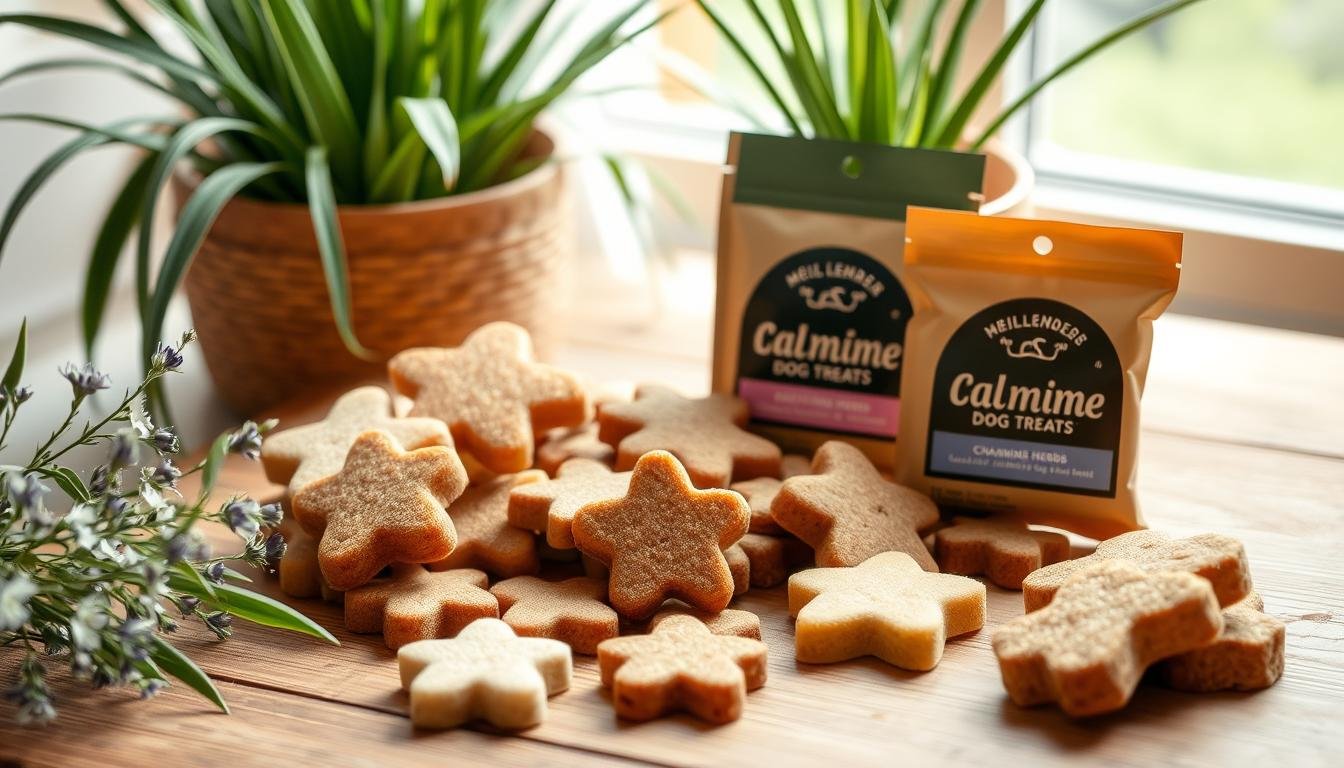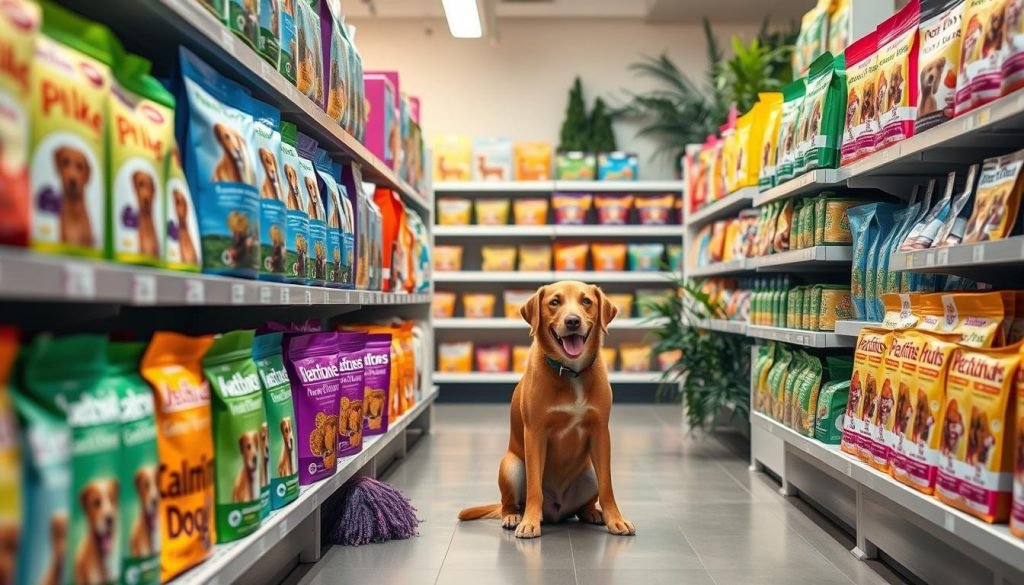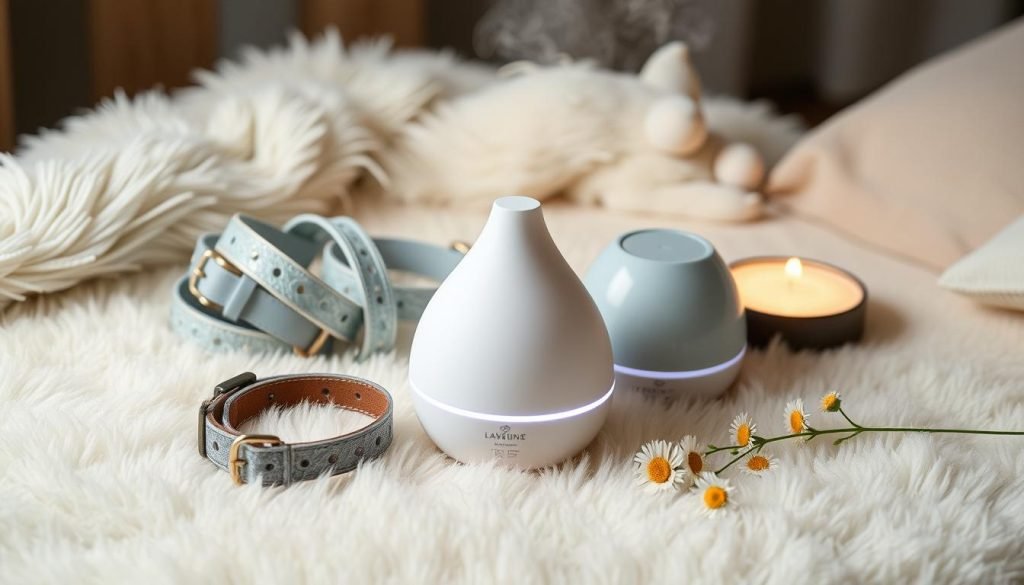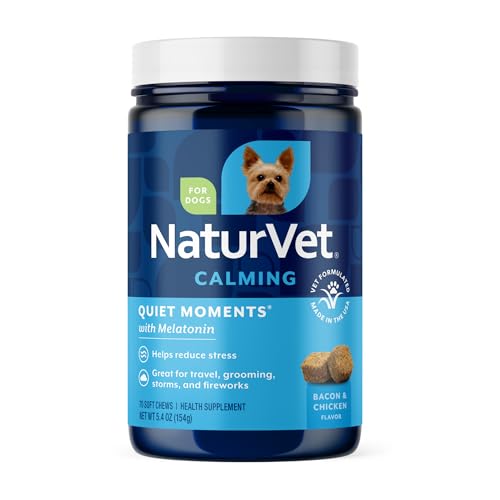
Dogs feel the weight of stress lift away with calming dog treats. While humans take deep breaths to feel better, pups munch on special snacks packed with gentle ingredients that help their worried minds settle down into a peaceful calm.
People are spending more and more on stress relievers for dogs—over $500 million just last year! When dogs get worked up, these treats help them relax as smoothly as melting butter.
Nature offers some powerful calming remedies for our furry friends. Chamomile can soothe a nervous dog during a scary thunderstorm. Valerian root and L-Tryptophan produce gentle relaxation effects.
How well the calming dog treats work depends on the dog’s size and health. Small dogs need lower doses than large ones. Vet consultations help owners determine the right amount.
Owners can combine calming dog treats with other calming methods too, like providing a quiet, comfortable space for dogs to relax and ensuring they get regular exercise to burn off nervous energy.
Understanding Anxiety in Dogs
Dogs get anxious a lot, just like people. You need to recognize the signs so you can help the pup calm down.
Most dog anxiety probably starts with fear of something. They might get super nervous when their owner leaves, if there’s a loud noise, or even just from seeing a new dog or person.
Anxious dogs show it in different ways too. Some might bark nonstop or chew up furniture. Others pace around or try to hide somewhere quiet. Vets say about 20% of dogs deal with this at some point.
Helping a stressed-out pup takes patience. Sometimes playing calming music helps them relax, or giving them a special toy to distract them. Calming dog treats can also be a helpful tool, offering a natural way to ease their anxiety. Training is huge too, to help build their confidence, kind of like teaching a kid to ride a bike.
If your dog shows their worries through whines and trembles, help is just around the corner. While vets understand what makes pups tick, gentle daily care can help turn scared dogs into relaxed companions who wag their tails at life again.
Common Causes of Anxiety in Dogs
Your dog shows anxiety from several key causes.
- Many dogs fear separation from you.
- Dogs hate loud noises like storms and fireworks.
- Dogs struggle with routine changes and new places.
- Dogs need proper social time and fresh activities.
- Past trauma affects dogs deeply. Medical problems cause pain and stress.
Your dog might show separation anxiety like many others. This affects 14% of all dogs today. Your older dog faces more anxiety through brain aging issues, linked to cognitive dysfunction syndrome (CDS).
Symptoms of Dog Anxiety
Dogs reveal their anxiety in everyday ways that pet owners can spot. When stressed, they often lick their lips repeatedly or leave trails of drool, while also yawning much more than usual, even when they’re not sleepy. These nervous pups pant heavily regardless of the temperature, their bodies shake or tremble, and they pace restlessly around the house, while some try to hide away from whatever scares them.
When anxiety takes hold, dogs sometimes lose their house training and have accidents indoors, or they take out their stress on furniture and belongings. The scratches and bite marks usually show up around doors and windows, where worried dogs try to escape. Their distress also comes out as non-stop barking, while some develop habits like chewing their paws raw or scratching at the same spot over and over.
Anxious dogs can turn aggressive in two main ways. Sometimes they lash out when someone steps between them and whatever’s making them nervous, while other times they directly attack people or other animals – a seriously dangerous situation that needs immediate attention.
You shouldn’t ignore these warning signs of dog anxiety. A quick trip to the vet rules out any health problems and opens up conversations about ways to help your nervous dog feel safe and calm again, possibly with the aid of calming dog treats to bring them some peace.
Benefits of Calming Treats for Dogs
Dogs show signs of stress, but natural calming dog treats can help them relax. Certain ingredients in these treats wash away the nerves and tension. Your furry friend finds peace during tough moments because of these special snacks.
Adding these calming dog treats to your dog’s daily life makes a real difference. Their tail wags more, and their eyes shine brighter as worry melts away.

How Calming Dog Treats Work
The magic behind these calming dog treats lies in nature’s own calm-down ingredients. These natural elements work with your dog’s brain, just like a gentle pat soothes away fears. Plants and proteins team up to bring peace to your nervous pup.
Mother Nature packs these treats with powerful helpers. Tryptophan, the same stuff that makes you sleepy after turkey dinner, helps your dog feel safe and content. Chamomile flowers, known for centuries to bring peace, work their gentle magic. Valerian root sends your pup into dreamland, while Theanine keeps them cool without getting drowsy. These ingredients work together like a cozy blanket for your dog’s mind.
When to Use Calming Dog Treats
Watch your dog’s body language to know when these calming dog treats will help most. Thunder rolls in the distance, and your dog starts to shake – that’s the perfect time for a calming treat.
If car rides make your dog’s tail tuck, just pop a calming dog treat in their mouth before you leave. Vet visits, new dog parks, or even seeing you grab your keys to go—these moments call for natural help too. Give these treats about half an hour before the scary times start, and watch your dog’s shoulders relax and breathing slow.
Key Ingredients in Calming Dog Treats
Dogs get anxious, and knowing what goes into their calming dog treats helps pick the right ones. Nature provides many plants and proteins that soothe worried pets. These ingredients have helped both people and animals feel calm for many years.

Two key helpers in these treats work like gentle back scratches for your dog’s nerves.
The first one, Tryptophan, turns into feel-good brain signals that wash away worry. Its partner, Theanine, spreads peace through your dog’s body like a warm blanket, helping them breathe easier during scary times.
Mother Nature’s medicine cabinet includes two more trusty soothers for anxious pups. Chamomile flowers work their magic just like they do in bedtime tea, helping dogs relax without knocking them out. Valerian root joins in as nature’s chill pill, helping scared dogs find their happy place again.
Dogs perk up their ears at the smell of hemp calming dog treats nowadays. These special snacks pack natural plant power that helps dogs stay cool under pressure. Hemp oil works alongside it, both teaming up to keep your dog feeling safe and steady.
Reading dog treat labels shows you what’s inside popular brands. Zesty Paws stuffs their chews with nature’s best soothers, while Calming Bites mix turkey with plant helpers. Both tell you exactly how many treats your dog needs based on their size.
Before grabbing any calming treats off the shelf, stop by your vet’s office for a chat. They’ll help figure out if your dog’s tail-tucking and trembling need special attention. Knowing these ingredients helps you pick treats that turn worried whimpers into content sighs.
| Brand | Key Ingredients | Dosage (per day) |
|---|---|---|
| Zesty Paws Calming Chews | Suntheanine, Ashwagandha, Chamomile, Valerian Root, Passion Flower, Hemp Seed Powder, L-Tryptophan | Up to 25lbs: 1 chew 26-75lbs: 2 chews Over 75lbs: 3 chews |
| Calming Bites™ – Turkey and Peanut Butter | Organic Chamomile, Organic Hemp Seed Powder, Valerian Root, Organic Passionflower, L-Theanine (Suntheanine®), Organic Ginger Root, Ashwagandha, L-Tryptophan, Magnesium Citrate | Consult packaging for weight-based dosage |
Choosing the Right Calming Treat for Your Dog
Dogs get scared sometimes, and picking the right calming dog treat matters just like choosing a cozy blanket. The perfect calming dog treats melt away their fears, while bad ones gather dust in the treat jar. Your dog’s wagging tail tells you when you’ve found the right match.

Considering Your Dog’s Size and Weight
Big dogs tower over tiny ones, needing bigger bites to feel peaceful. Your German Shepherd needs three treats while your friend’s Yorkie nibbles half of one. Every treat box shows pictures of different-sized dogs with their proper portions, making treat time simple and safe.
Flavor and Palatability
Treats catch your dog’s nose before touching their tongue. Beefy ones make them drool puddles on the floor, while chicken flavors spark tail wags and happy dances. Some pups bounce at the smell of liver, others perk up for peanut butter. Each brand packs different tastes into their calming treats.
Potential Allergens and Sensitivities
Red spots pop up on some dogs after eating wheat, while others scratch endlessly after beef treats. Fresh food allergies show up as belly rumbles and itchy ears. Plain calming dog treats with just a few natural ingredients keep sensitive dogs from turning into scratching machines.
Store shelves hold rows of different calming dog treats, each promising peaceful pups. NaturVet’s purple bag holds thousands of happy dog stories, while Zesty Paws packs extra strength into orange chews. VetriScience keeps their recipe simple, using just three powerful plant helpers.
| Calming Treat | Key Features |
|---|---|
| NaturVet Quiet Moments Calming Aid Dog Supplement | Most reviewed calming dog treat on Amazon with over 30,000 reviews |
| Zesty Paws Calming Soft Chews for Dogs | Contains Suntheanine, a premium and pure form of L-theanine, for optimal calming effects |
| VetriScience Composure Calming Treats | Limited ingredient formula with only three active ingredients for targeted stress and anxiety relief |
Dogs shake during loud storms and pant through car rides, so match their treats to these tough times. The calming bits spread peace through their body for about four to eight hours, helping scared paws walk steady again. Watch your dog’s face – when worried eyes turn to gentle snores, you’ve found their perfect treat.
Top Brands of Calming Dog Treats That Calm Dogs
Dogs get scared and jumpy, but certain calming dog treats help them calm down. Different brands make special snacks that turn nervous pups into relaxed companions. Let’s look at which treats work best for worried dogs.
VetriScience Composure chews melt away dog stress in just half an hour. Dogs nibble these soft calming dog treats while their body soaks up the calming helpers inside. The peaceful feeling stays for four hours, giving both dogs and owners a break from anxiety.
ThunderWorks wraps scared dogs in a cozy vest that feels like a gentle hug. Dogs from tiny Yorkies to huge Great Danes can wear this snug jacket. Straps adjust to fit any wiggly body, keeping the comfort steady all day long.
Store shelves hold rows of different calming dog treats, each promising help for worried pups. NutriPaw fills big tubs with treats that have already helped thousands of dogs stop shaking. GKD Hemp Calming Teats pack power into their chews, while NaturVet adds sleep helpers and ginger to their recipe. DuoXingTang’s treats work fast, and Solid Gold keeps their ingredients pure and simple.
Dogs show different signs of stress, and their size affects how many calming dog treats they need. Little pups might settle down with half a treat, while big dogs may require two or three to feel peaceful. The pictures on treat bags indicate exactly how many to give, helping your dog find their calm spot safely.
Alternatives to Calming Treats
Dogs show fear in many ways, while treats help some pups feel better. Different tools and tricks help scared dogs face their fears. Looking at all the choices helps find what works for each nervous pup.

Calming Collars and Pheromone Diffusers
Special collars and room plug-ins spread calming smells through the air. These scents remind dogs of their mom’s soothing presence from puppy days. Adaptil makes collars that wrap this comfort around your dog’s neck, while ThunderEase fills rooms with peaceful vibes.
Anxiety Wraps and Thundershirts
Snug jackets wrap scared dogs in gentle hugs during scary times. Thunder booms overhead as your dog stays calm in their special vest. ThunderShirt makes these comfort wraps in different sizes, helping both tiny Chihuahuas and huge Great Danes feel safe.
Behavioral Training and Desensitization
Dog trainers teach scared pups to face their fears step by step. Your pup might start by watching fireworks from far away, then slowly move closer as their courage grows. Patient teachers help dogs learn to stay calm, turning scary moments into peaceful ones.
| Calming Aid | How It Works | Best For |
|---|---|---|
| Calming Collars and Pheromone Diffusers | Releases synthetic pheromones that mimic a mother dog’s natural calming pheromones | General anxiety, separation anxiety, travel, and new environments |
| Anxiety Wraps and Thundershirts | Provides gentle, constant pressure around the dog’s body, creating a calming effect | Thunderstorms, fireworks, travel, and vet visits |
| Behavioral Training and Desensitization | Teaches dogs to cope with anxiety-inducing situations through gradual exposure and positive reinforcement | Specific phobias, separation anxiety, and generalized anxiety |
Each helper works differently, matching different kinds of dog fears. Smell helpers work great for everyday worries, while pressure vests shine during loud storms. Training builds lasting bravery for specific scary things like vet visits or loud noises.
Dogs bark different tunes of worry, so finding the right help takes time. Some pups calm down with special smells, while others need snug hugs to feel brave. Talk with your vet about trying these helpers – they know which ones might work best for your dog.
Safety Considerations and Precautions
Giving dogs calming treats needs careful watching. Most dogs drool and wag their tails while munching these treats, but checking with your vet makes sense before mixing new food into their daily bowls.
Consulting with Your Veterinarian
Your local vet spots problems that regular dog owners might miss. As dogs bounce around the exam room, vets check their overall health and any medicines they’re taking. Some dogs need basic training instead of calming dog treats, while others might need real medicine to feel better.
Pet treats sit on store shelves without the testing that human pills get. Walking down the pet store aisle, you’ll see dozens of brands making big promises. Your vet knows which calming dog treats actually work, as they see dogs come through their office doors every day.
Proper Dosage and Administration
Dogs need different amounts of calming dog treats to stay calm. Some pups munch small pieces while others grab bigger bites until they settle down. As thunder rumbles, certain dogs dash for quick-acting treats, while others need their daily dose with breakfast.
Watch your dog’s body language after calming dog treat time. Their paws might drag across the floor while their eyes grow heavy, and you’ll notice if something seems off. Until you’re sure the treats work well, keep checking how your friend acts and moves around the house.
Start with small measured amounts and watch what happens. While following package directions, notice how your dog reacts to each bite. As your pup tries new calming dog treats, look for any weird behavior or sluggish movement until you’re sure they’re doing fine.
Safe treats lead to calmer dogs. Watch closely as your dog adjusts to new calming dog treats, and call the vet right away if anything looks wrong. Working together with your vet helps find what works best for keeping your dog relaxed.
Conclusion
Dogs often respond differently to calming dog treats, making it a journey to discover the right match. Some pups gobble down chicken-flavored chews while others turn their nose up, leading owners to test various options. Watch your furry friend’s body type, eating habits, and any food troubles they’ve shown before picking treats.
Anxiety relief through calming dog treats helps many pets but doesn’t work magic on deep-rooted fears. A rescue dog scared of thunderstorms since puppyhood won’t suddenly love storms after a few treats. Check with your vet first – they know your dog’s health history and can suggest safe starting amounts that match your pet’s needs.
Large breeds like Great Danes process ingredients slower than tiny Chihuahuas, though piling on extra treats won’t speed things up. Keep a close eye on how your dog acts after trying new calming dog treats, sticking to the amounts your vet recommends.
Soothing treats work best as part of a bigger plan to help nervous dogs relax. Mix in gentle training sessions and slowly expose them to scary things in small doses. When treat time and training aren’t enough to calm your shaking pup, dog behavior experts can step in with detailed plans tailored just for your pet.
Time, care, and finding the right combination of help lets anxious dogs bloom into more confident companions. Soon enough, those worried eyes and tucked tails can give way to relaxed, happy pets enjoying life by your side.
FAQ
What are the most common ingredients in calming treats for dogs?
Dogs gobble up natural soothers like chamomile and melatonin in calming dog treats. While some treats pack hemp oil or CBD, others mix in gentle helpers like valerian root and L-theanine, as these work together to melt away doggy stress.
How long does it take for calming treats to start working?
Treats kick in at different speeds, leaving some pups relaxed within half an hour while others need more time. Most owners slip their dogs these snacks about 30 minutes before scary stuff happens, as the calming effect can last through an entire stormy evening or car ride.
Can I give my dog calming treats every day?
Daily doses work fine for most furry friends, though watching the amount matters. While regular calming dog treats help keep anxiety at bay, giving too many leads to a sluggish pup, so stick to what the package says.
Are there any potential side effects of using calming treats?
Some dogs might drag their feet or turn down breakfast after having these treats. When your buddy acts weird or their stomach growls more than usual, it’s time to stop the treats and check with the vet.
Can I use calming treats in combination with other anxiety treatments?
Mix calming dog treats with other tricks like snug anxiety wraps or plug-in diffusers that spread soothing scents. While combining methods often works better, run your plan by the vet first to keep your pup safe.
Are calming treats effective for all types of anxiety in dogs?
Mild worriers often perk up with these treats in their daily routine. But when your dog shakes at every doorbell or hides during walks, treats alone won’t fix the fear—that’s when dog experts need to step in with bigger solutions.


 Amazon.com
Amazon.com 







